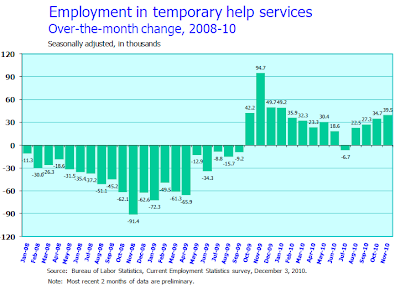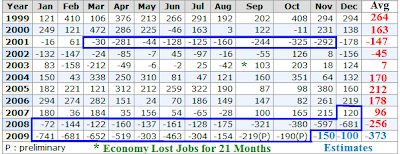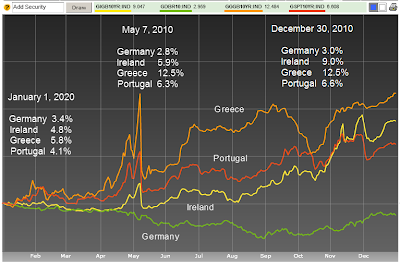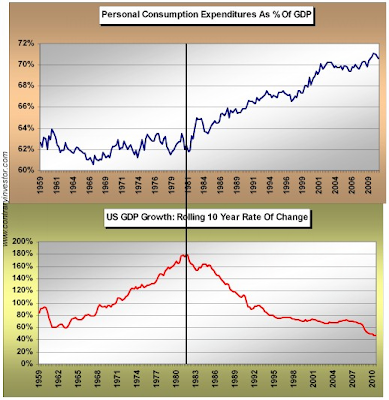Calculated Risk, a good friend of mine, has come up with employment projections for 2011. He thinks the economy will grow by 2.4 million private jobs (200,000 a month), with an upside chance of 3 million jobs.
I think those estimates are extremely high and we will not come close to even 2.4 million jobs. I give my rationale below, but first let's see what Calculated Risk has to say.
Please consider Calculated Risk's
Question #5 for 2011: EmploymentThe U.S. economy added about 87 thousands payroll jobs per month in 2010 through November. This was extremely weak payroll growth for a recovery. How many payroll jobs will be added in 2011?
The U.S. will add around 1.2 million private sector jobs in 2010. And this despite the construction sector losing over 100 thousand jobs in 2010 (the fourth year in a row of construction job losses).
It now appears that job creation is picking up, and it also appears that the construction sector will add employees for the first time since 2006. There were over 2 million construction jobs lost during the downturn, and a relatively small number will be added next year - but every little bit will help.
This suggests to me that private payroll employment will increase by over 2 million jobs next year, maybe as high as 3 million jobs! My guess is around 2.4 million jobs as shown on the following graph.

Of course state and local governments will probably lose some jobs, but it looks like 2011 will be the best year for private job creation since the '90s.
What is the Driver for Jobs?One question I continually ask is "What is the driver for jobs?"
Let's address that question, sector by sector, using all the major component breakdowns of job categories by the BLS, starting with the
BLS Current Statistics reports for October or November (the latest graphs available).
Please click on any chart below to see a sharper image.

For all the brouhaha about the manufacturing recovery, employment in the manufacturing sector has dropped four consecutive months. Before estimating manufacturing for 2011, let's look at the long-term chart.

That does not look so pretty. Nonetheless, manufacturing averaged +10,000 jobs a month in 2010. Will 2011 look more like the first half of 2010, more like the second half, more like the long-term trend, or more like another temporary flattening out?
I will take an average of 2010 as a guess.
Manufacturing Jobs Expectation for 2011 is +10,000 per month.

January and February were a disaster for construction in 2010 so let's drop those. The average March through November is +3,000. Let's be generous and round to the nearest 5,000.
Construction Jobs Expectation for 2011 is +5,000 per month.

The average number of mining jobs January-October 2010 is +8,000.
Mining Jobs Expectation for 2011 is +8,000 per month.

Temporary help services was one bright spot in 2010. The January-November average is +27,000 a month. The August-November average is 31,000 a month. Let's be generous and add 4,000 jobs a month to the August-November total.
Temporary Help Services Jobs Expectation for 2011 is +35,000 per month.
BLS has Temporary Help as a subcomponent of Professional and Business Services. It is hard to say whether or not permanent hiring takes hold but if it does it will likely be at some expense to Temporary Help.
There are no charts available for Professional and Business Services, but let's add another 10,000 jobs a month to give a total of +45,000 jobs per month for Professional and Business Services.

Retail trade was certainly all over the map in 2010. I am not sure what to make of these big swings. The average for January-November 2010 is +6,000.
Retail Trade Jobs Expectation for 2011 is +6,000 per month.

Let's discard January and February as not being representative of the year. The 9 month average March-November is 9,000.
Transportation and Warehousing Jobs Expectation for 2011 is +9,000 per month.
Financial activities is one sector that did not recover in 2010. Look for a repeat in 2011. Mortgage refinancing is falling off a cliff. I expect bank warnings about profits and lots of layoffs in this sector as a result of rising interest rates in general and mortgage rates in particular.
The average number of jobs January-November is -7,000. Look for a repeat with job losses stacked in the first half.
Financial Activities Jobs Expectation for 2011 is -7,000 per month.
The January-November average is +15,000. I think we have seen some of the restaffing we are going to get and growth in 2011 will not be as robust.
Leisure and Hospitality Jobs Expectation for 2011 is +10,000 per month.
Healthcare has been a rock solid performer throughout the recession. The one possible downside to 2011 is cutbacks at country hospitals over budget concerns. Otherwise a continuation of 2010 seems likely. The average for January-October is +20,000. Let's ignore the downside risk and be slightly generous, using the average of the latest 4 months.
Healthcare Jobs Expectation for 2011 is +24,000 per month.The BLS groups education and healthcare together in the monthly jobs reports (why I do not know). However in these summary reports the BLS breaks out healthcare separately. There are no charts for education.
Education is one of the big wildcards. Traditionally this is a growing segment. However, cities are under a lot of pressure here. There could be losses in this component, perhaps big losses with increasing class sizes unless teachers' unions take pay or benefits cuts or unless help comes from the federal government. I am going to assume no growth in education as a middle ground.
Education Jobs Expectation for 2011 is +0 per month.Wholesale trade is a minor jobs component. I do not have a chart, but will assume a nominal amount of growth.
Wholesale Trade Jobs Expectation for 2011 is +3,000 per month.Information is a very minor jobs component. I do not have a chart. The last three months were -7,000, -1,000, and +1,000. Let's assume +1,000 a month.
Information Jobs Expectation for 2011 is +1,000 per month.
I do not have a chart of Other Services . The last three months were +17,000, +30,000, and -8,000. The average is +13,000.
Other Services Jobs Expectation for 2011 is +13,000 per month.
Note how local governments were still expanding mid-recession, all the way up till July of 2008. A year later, starting June of 2009, local governments finally got religion and started cutting jobs. Look for this trend to continue into 2011.
The average number of local government jobs for January-November 2010 was -21,000. Let's assume it will be the same for 2011 although there could be a disaster coming up at the local level.
Local Government Jobs Expectation for 2011 is -21,000 per month.

In spite of all the whining at the state level, states have not yet made any significant cuts in employment. The average for January-November 2010 rounded to the nearest 1,000 is 0. Let's assume there will be no net gains or cutbacks at the state level for 2011, even though I expect some losses.
State Government Jobs Expectation for 2011 is +0 per month. Total private employment January-November 2010 was +1.2 million. Total nonfarm employment was +951,000. That means 249,000 government jobs were lost so far in 2010. Of those 231,000 were local government jobs and none at the state level. Thus a net of 18,000 jobs, about 1,000 a month were lost at the Federal level. Instead, let's assume no net federal jobs for 2011.
Federal Government Jobs Expectation for 2011 is +0 per month. Totals and Subtotals by Category
I come up with +127,000 private jobs a month in comparison to Calculated Risk's estimate of +200,000 jobs a month. That is quite a difference.
I have total nonfarm jobs at +106,000.
Let's do a reality check.
Monthly Job Growth 1999-2009
Chart courtesy of
BLS. Annotations by me, numbers are in thousands.
The areas in deep blue mark recessions.
- At the height of the internet bubble with a nonsensical Y2K scare on top of that, the economy managed to gain 264,000 jobs a month.
- At the height of the housing bubble in 2005, the economy added 212,000 jobs a month.
- At the height of the commercial real estate bubble with massive store expansion, the economy added somewhere between 96,000 and 178,000 jobs per month depending on where you mark the peak.
Neither the housing boom, nor the commercial real estate boom is coming back. Nor is there going to be another internet revolution. If anything, outsourcing of jobs to Asia is likely to remain intense.
Finally, consider all the financial engineering jobs, banking jobs etc, that are not coming back.
I simply do not see any driver for jobs. Many of these optimistic scenarios are based on a "typical recovery". Well this is not going to be a typical recovery. Indeed, it already is not a typical recovery.
Furthermore, Europe is a basket case, the housing bubbles in Australia and Canada are popping, China and India are both overheating and will slow, and topping it off, there is a very genuine chance that the retail hiring done for the Christmas season is all we get.
Store expansion is not going to be like it was in 2006-2007.
OK there is going to be more money in paychecks because of a reduction in Social Security collection. In response, I see ever increasing estimates as to how much that payroll tax cut will add to GDP.
However, I have to ask "How much of that payroll tax cut will go to increased sales taxes, state income taxes, and property taxes?"
I have not seen anyone properly address that question. I suggest we need that payroll tax cut to break even. Certainly taxes of all kinds are going up in Illinois. Our idiotic governor wants to hike income taxes 33%. Sales taxes will likely go up as well.
While Illinois may be an extreme example, bear in mind that places where taxes are not going up will see more layoffs.
Thus, from every angle, I struggle mightily to come up with +200,000 a month. Note that I stretched in several places to be purposely optimistic, tossing out bad months at the beginning of the year, etc. If everything goes right, perhaps we can add 160,000 jobs a month, but that assumes I am way off on the education component.
If the economy does add 160,000 private jobs a month, depending on government cutbacks, the unemployment rate will barely drop, and in fact might not even drop at all.
At +100,000 to +125,000 total jobs a month, the unemployment rate will likely rise. Given all the tremendous risks, the economy might not add that.
Mike "Mish" Shedlock
http://globaleconomicanalysis.blogspot.com
Click Here To Scroll Thru My Recent Post List 



























